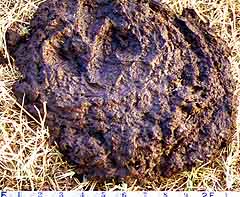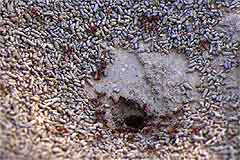Patricia & Dick Richardson
Summary: Favored by managed grazing, dung beetles in Oklahoma buried about 1 ton of wet manure per acre per day (2 metric tons/ha). This increased water infiltration an average of 129% on studied plots. Each extra inch (25 mm) of water absorbed adds 27,225 gallons/acre (254,530 l/ha) of water to the soil, reducing both flooding and drought.
Healthy soil is an extremely complex civilization of living organisms. We humans often ignore using soil organisms as a tool, because they are so small, so easily out of sight and out of mind. Yet, healthy soil is the corner stone of diversity and health for both plants and animals.
Pat Richardson
 Fresh cow pad. Pat Richardson
 13 hours later, after being worked by O. gazella dung beetles. Pat Richardson

 Earthworms first appeared where dung beetles were most active. Today harvester ants build their mounds with earthworm castings. |
On pasture and rangeland grazed by livestock, the dung beetle is a soil organism that is visible to humans, beneficial to soil health and easily monitored. They are valuable as a soil restoration tool to increase organic matter, aerate, remove non-point source pollution, increase water infiltration, and help control pest insects. They work for free and love their work. The only consideration needed is to not use insecticides/parasiticides that poison them.
Our primary study site comprises 2500 grazed acres (1000 hectares) on the Davis Ranch in southern Oklahoma. Dung beetles were one of the surprise "tools" that appeared when Walt stopped using insecticides in 1975. About a year later, he began to notice that dung piles (cow pads) were looking "worked" (riddled with holes, spread out) and were disappearing. He also began to see small brown beetles flying to and from cow pads particularly at dawn and dusk. They were identified as Onthophagus gazella, a tropical species of dung beetle introduced by the U. S. Department of Agriculture in the mid 1970's for bio-control of pest face and horn flies.
Over the years, the Davis ranch dung beetle population (currently 5 identified species) has grown to such numbers, that when rainfall is normal and stock density is at peak levels, Walt estimates that where the herd is, the beetles bury a ton of wet manure per acre per day (2 metric tons/ha) and remove 90% of the surface material. He moves his cattle as a dense herd through a series of pastures, allowing him the flexibility to plan their return adjusted to healthy re-growth of desired grasses and forbs. The pattern of movement and density of cattle provide an easily located, relatively concentrated supply of manure. Dung beetles sequester and bury manure to use as both incubator and food source for their young. The adults feed by removing nutrient laden liquids from fresh dung. Walt has dug as deep as 18 inches in his pastures and still found no end to their tunnels (sandy clay loam soil). In drought times they desiccate cow pads, but do not bury as much as in favorable rainfall times.
In 1998 at the Davis ranch, there was a late freeze (April 17-18) which reduced O. gazella numbers, followed by a long, dry, hot spell lasting through summer. We spent a week at the ranch in July in above 100°F. temperatures (> 40°C) studying dung beetle activity. One evening at dark, from an average cow pad, I counted 206 dung beetles exiting in 6 minutes.I could hear the activity in that cow pad (lots of snaps, crackles, pops). Cow pads were being spread out and desiccated within 48 hours, but dry manure was still mixed with undigested plant material. In contrast, we have watched a horse pile, plopped on a south Texas ranch during a lush spring, disappear underground in 24 hours, leaving only a soft fluffy layer of undigested plant material. John Feehan of Australia has counted as many as 1000 dung beetles in a cow pad, effecting complete burial in several hours (personal communication). It will be interesting to measure dung beetle activity at the Davis ranch in a favorable rainfall year.
O. gazella is the work horse so far at the Davis ranch, but the ranch is near the northern limit of its range. Multiple species of dung beetles are important:
- for more uniform distribution and burial of dung (directly below the pad at different depths and rolled away);
- to have dependable activity throughout each 24 hour period (day and night fliers) and over more of the year (warm and cold tolerant).
We have compared water infiltration rates where a cow pad has been buried by dung beetles vs. no cow pad on a variety of pasture and soil conditions. We find on average a 129% increase in infiltration rate over control (Table 1). An extra inch (25 mm) of rainfall absorbed per acre means the addition of 27,225 gallons/acre (254,530 l/ha) of water in the soil, reducing the detrimental effects of either drought or flood years.
Table 1. Water infiltration rate (inches/hour) for 6 sites resulting from dung beetle activity.
| Site | Control (in/hr) | Buried Cow Pad (in/hr) | Increase over Control (in/hr) | Increase as Percent of Control |
|---|---|---|---|---|
| 1 | 2.25 | 6.35 | 4.10 | 182% |
| 2 | 2.55 | 11.38 | 8.83 | 346% |
| 3 | 10.75 | 17.19 | 6.44 | 60% |
| 4 | 2.76 | 3.92 | 1.16 | 42% |
| 5 | 10.75 | 17.39 | 6.64 | 62% |
| 6 | 1.50 | 2.74 | 1.24 | 83% |
| Mean | 5.09 | 9.83 | 4.741 | 129% |
1 p<0.01
In 1975, Walt could find no earthworms in his pasture soils. Over the next decade, in areas where he observed concentrated dung beetle activity, he also began to see earthworm castings. At a 1996 field day at the ranch, he dug large core soil samples from a number of these pastures and counted 12 to 30 earthworms per cubic foot. Today, at several sites on the ranch, harvester ants have built their mounds out of earthworm castings. We like to think of this type of reuse as a most elegant sign of rangeland health.
-- Pat & Dick Richardson
© 2000
Patricia Q. and R. H. (Dick) Richardson, Integrative Biology, University of Texas, Austin TX 78712, voice 512/471-4128, FAX 512/471-3878, e-mail: d.richardson@mail.utexas.edu; and W. W. Davis, Rt. 2 Box 147, Bennington OK 74723, 580/847-2384, FAX 580/847-2445, e-mail: wwdranch@aol.com
Published in Ecological Restoration 18:116-117. (2000)
URL: managingwholes.com/dung-beetles.htm
Related articles and links